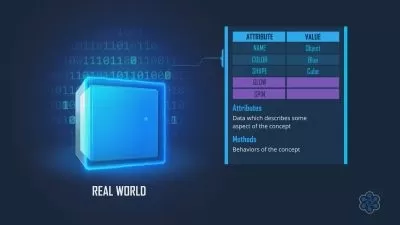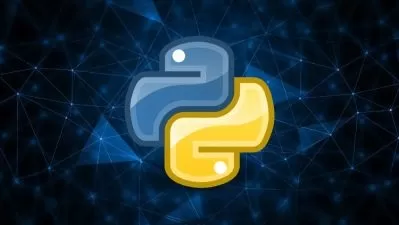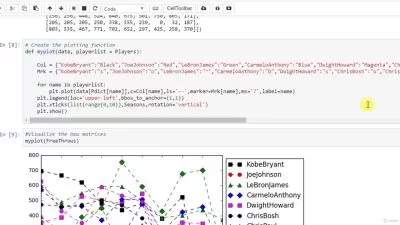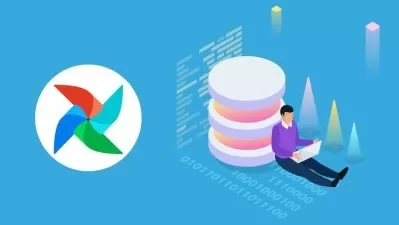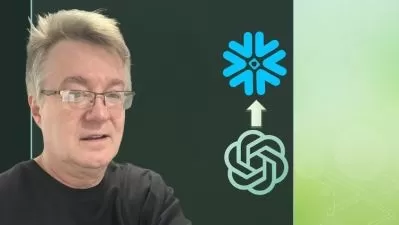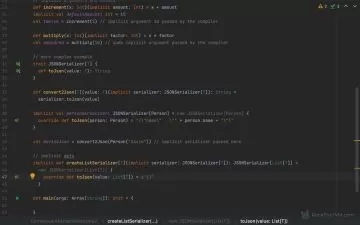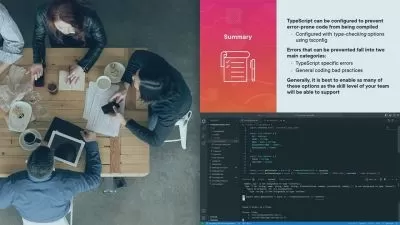QC101 Quantum Computing & Intro to Quantum Machine Learning
Kumaresan Ramanathan
11:50:02
Description
Math-Based Introduction to Quantum Computing, Cryptography & Quantum Machine Learning. Code with Python, Q#, & Qiskit
What You'll Learn?
- Use quantum cryptography to communicate securely
- Develop, simulate, and debug quantum programs on IBM Qiskit and Microsoft Q#
- Run quantum programs on a real quantum computer through IBM Quantum Experience
- Use Dirac's notation and quantum physics models to analyze quantum circuits
- Train a Quantum Support Vector Machine (Quantum Machine Learning) on real-world data and use it to make predictions
- Learn Data science and how quantum computing can help in artificial intelligence / machine learning
- Learn why machine learning will be the killer-app for quantum computing
Who is this for?
More details
DescriptionWelcome to the bestselling quantum computing course on Udemy!
Quantum Computing is the next wave of the software industry. Quantum computers are exponentially faster than classical computers of today. Problems that were considered too difficult for computers to solve, such as simulation of protein folding in biological systems, and cracking RSA encryption, are now possible through quantum computers.
How fast are Quantum Computers? A 64-bit quantum computer can process 36 billion billion bytes of information in each step of computation. Compare that to the 8 bytes that your home computer can process in each step of computation!
Companies like Google, Intel, IBM, and Microsoft are investing billions in their quest to build quantum computers. If you master quantum computing now, you will be ready to profit from this technology revolution.
This course teaches quantum computing from the ground up. The only background you need is 12th grade level high-school Math and Physics.
IMPORTANT: You must enjoy Physics and Math to get the most out of this course. This course is primarily about analyzing the behavior of quantum circuits using Math and Quantum Physics. While everything you need to know beyond 12th grade high school science is explained here, you must be aware that Quantum Physics is an extremely difficult subject. You might frequently need to stop the video and replay the lesson to understand it.
QUANTUM MACHINE LEARNING
It appears that the killer-app for quantum computing will be machine learning and artificial intelligence.
Quantum machine learning algorithms provide a significant speed-up in training. This speed-up can result in more accurate predictions.
While understanding quantum algorithms requires mastery of complex math, using quantum machine learning is relatively simple. Qiskit encapsulates machine learning algorithms inside an API that mimics the popular Scikit-Learn machine-learning toolkit. So you can use quantum machine learning almost as easily as you would traditional ML!
Quantum machine learning can be applied in the back-end to train models, and those trained models can be used in consumer gadgets. This means that quantum machine learning might enhance your everyday life even if quantum computers remain expensive!
COURSE OUTLINE
We begin by learning about basic math. You might have forgotten the math you learned in high-school. I will review linear algebra, probability, Boolean algebra, and complex numbers.
Quantum physics is usually considered unapproachable because it deals with the behavior of extremely tiny particles. But in this course, I will explain quantum physics through the behavior of polarized light. Light is an everyday phenomenon and you will be able to understand it easily.
Next we learn about quantum cryptography. Quantum cryptography is provably unbreakable. I will explain the BB84 quantum protocol for secure key sharing.
Then we will learn about the building-blocks of quantum programs which are quantum gates.
To understand how quantum gates work, we will study quantum superposition and quantum entanglement in depth.
We will apply what we have learned by constructing quantum circuits using Microsoft Q# (QSharp) and IBM Qiskit. For those of you who don't know the Python programming language, I will provide a crisp introduction of what you need to know.
We will begin with simple circuits and then progress to a full implementation of the BB84 quantum cryptography protocol in Qiskit.
We will learn how to use Qiskit's implementation of Shor's algorithm for factoring large numbers.
The killer-app for quantum computing is quantum machine learning.
To understand quantum machine learning, we must first learn how classical machine learning works. I provide a crisp introduction to classical machine learning and neural networks (deep learning).
Finally, we will train a Quantum Support Vector Machine on real-world data and use it to make predictions.
For a better learning experience, open the transcript panel.
  You will see a small "transcript" button at the bottom-right of the video player on Udemy's website. If you click this button, the transcript of the narration will be displayed. The transcripts for all the videos have been hand-edited for accuracy. Opening the transcript panel will help you understand the concepts better.
  If you missed an important concept, then you can click on text in the transcript panel to return directly to the part you want to repeat. Conversely, if you already understand the concept being presented, you can click on text in the transcript panel to skip ahead in the video.
Enroll today and join the quantum revolution!
Who this course is for:
- Software professionals and technical managers who want to learn quantum computing and enjoy Math & Physics
- Machine Learning and AI professionals who want to learn how quantum computing can be used in data science
Welcome to the bestselling quantum computing course on Udemy!
Quantum Computing is the next wave of the software industry. Quantum computers are exponentially faster than classical computers of today. Problems that were considered too difficult for computers to solve, such as simulation of protein folding in biological systems, and cracking RSA encryption, are now possible through quantum computers.
How fast are Quantum Computers? A 64-bit quantum computer can process 36 billion billion bytes of information in each step of computation. Compare that to the 8 bytes that your home computer can process in each step of computation!
Companies like Google, Intel, IBM, and Microsoft are investing billions in their quest to build quantum computers. If you master quantum computing now, you will be ready to profit from this technology revolution.
This course teaches quantum computing from the ground up. The only background you need is 12th grade level high-school Math and Physics.
IMPORTANT: You must enjoy Physics and Math to get the most out of this course. This course is primarily about analyzing the behavior of quantum circuits using Math and Quantum Physics. While everything you need to know beyond 12th grade high school science is explained here, you must be aware that Quantum Physics is an extremely difficult subject. You might frequently need to stop the video and replay the lesson to understand it.
QUANTUM MACHINE LEARNING
It appears that the killer-app for quantum computing will be machine learning and artificial intelligence.
Quantum machine learning algorithms provide a significant speed-up in training. This speed-up can result in more accurate predictions.
While understanding quantum algorithms requires mastery of complex math, using quantum machine learning is relatively simple. Qiskit encapsulates machine learning algorithms inside an API that mimics the popular Scikit-Learn machine-learning toolkit. So you can use quantum machine learning almost as easily as you would traditional ML!
Quantum machine learning can be applied in the back-end to train models, and those trained models can be used in consumer gadgets. This means that quantum machine learning might enhance your everyday life even if quantum computers remain expensive!
COURSE OUTLINE
We begin by learning about basic math. You might have forgotten the math you learned in high-school. I will review linear algebra, probability, Boolean algebra, and complex numbers.
Quantum physics is usually considered unapproachable because it deals with the behavior of extremely tiny particles. But in this course, I will explain quantum physics through the behavior of polarized light. Light is an everyday phenomenon and you will be able to understand it easily.
Next we learn about quantum cryptography. Quantum cryptography is provably unbreakable. I will explain the BB84 quantum protocol for secure key sharing.
Then we will learn about the building-blocks of quantum programs which are quantum gates.
To understand how quantum gates work, we will study quantum superposition and quantum entanglement in depth.
We will apply what we have learned by constructing quantum circuits using Microsoft Q# (QSharp) and IBM Qiskit. For those of you who don't know the Python programming language, I will provide a crisp introduction of what you need to know.
We will begin with simple circuits and then progress to a full implementation of the BB84 quantum cryptography protocol in Qiskit.
We will learn how to use Qiskit's implementation of Shor's algorithm for factoring large numbers.
The killer-app for quantum computing is quantum machine learning.
To understand quantum machine learning, we must first learn how classical machine learning works. I provide a crisp introduction to classical machine learning and neural networks (deep learning).
Finally, we will train a Quantum Support Vector Machine on real-world data and use it to make predictions.
For a better learning experience, open the transcript panel.
  You will see a small "transcript" button at the bottom-right of the video player on Udemy's website. If you click this button, the transcript of the narration will be displayed. The transcripts for all the videos have been hand-edited for accuracy. Opening the transcript panel will help you understand the concepts better.
  If you missed an important concept, then you can click on text in the transcript panel to return directly to the part you want to repeat. Conversely, if you already understand the concept being presented, you can click on text in the transcript panel to skip ahead in the video.
Enroll today and join the quantum revolution!
Who this course is for:
- Software professionals and technical managers who want to learn quantum computing and enjoy Math & Physics
- Machine Learning and AI professionals who want to learn how quantum computing can be used in data science
User Reviews
Rating
Kumaresan Ramanathan
Instructor's Courses
Udemy
View courses Udemy- language english
- Training sessions 274
- duration 11:50:02
- English subtitles has
- Release Date 2023/05/17






